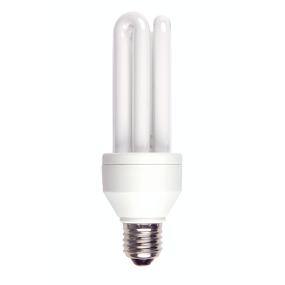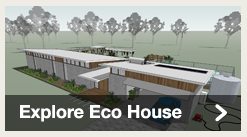Build it Back Greenbushfires
Lighting
 The aim of lighting is to provide enough light to
suit requirements, with some rooms in a home needing more lighting
than others. For example, kitchens need to be well lit for chopping
veggies without chopping fingers, whereas in lounge-rooms bright
lighting may be a distraction from watching television and bedrooms
are usually better with lower lighting levels.
The aim of lighting is to provide enough light to
suit requirements, with some rooms in a home needing more lighting
than others. For example, kitchens need to be well lit for chopping
veggies without chopping fingers, whereas in lounge-rooms bright
lighting may be a distraction from watching television and bedrooms
are usually better with lower lighting levels.
When looking at the energy consumption of lights look at the wattage, not the voltage. Many lamps, particularly halogen downlights, are sold as 'low voltage', with the packaging implying that this equates to low energy consumption, which is not the case.
Incandescent lamps
Incandescent lamps are the oldest common form of lightbulb. Generally incandescents have an efficiency of between 2% and 7% (the rest of the energy-93% to 98%-is turned into heat!). Due to their inefficiency the federal government is phasing out the sale of incandescent light bulbs in Australia. The first stage of the phase-out plan was the introduction of an import restriction on inefficient incandescent light bulbs used for general lighting purposes from 1 February 2009. There are now many more efficient light bulbs available such as compact fluroresents and LEDs.
Halogen lamps
Halogen downlights are a type of incandescent lamp, which work by heating a small piece of metal to white heat to produce light. More than 90 per cent of the energy that goes into common halogen lights turns into heat; as a result, the lights use more electricity than needed making them very inefficient.
While halogen downlights are good for direct task lighting their popularity has exceeded their purpose as they are now being used to light entire rooms. Halogen downlights also use additional energy as they require the use of a transformer that is usually located in the ceiling above each light fitting. The transformers produce heat, so if they are installed in the roof cavity they may pose a fire risk. This decreases the effectiveness of the insulation in your roof.
A complete change of lamps is an option which may require some time and money in the short term, but in the long term will largely reduce lighting costs by increasing energy efficiency. LED downlights cost between $10 and $100 but last 50,000 hours. Also, mini compact fluorescent downlight fittings could be used as an alternative to halogen downlights or compact fluorescent downlights and fittings.
Fluorescent lamps
Most people are familiar with the common strip fluoro, which usually uses a two-foot or four-foot long straight tube. Fluoros have a very high efficiency and long lifespan.
However there are several perceived disadvantages with fluoros that has stopped their widespread use. The first is their large size. Flickering is another problem many people dislike with fluoros. Another common complaint is the type of light produced. Cheap fluoro fittings usually come with a cheap and nasty tube that puts out quite a bluish light with a high colour temperature. Always use a triphosphor or quadphosphor tube for a high efficiency and better quality light.
Compact fluorescent lamps
Compact fluorescents work on the same principle as regular fluorescent lamps, except their tube is smaller in diameter and folded into a number of loops or wound in a spiral shape. This allows CFLs to run at efficiencies similar to a regular fluoro, without taking up so much space or needing dedicated fluoro tube light fittings. There is now a wide range of CFLs available that come in different sizes, shapes and colours including warm white. Because they contain electronic components, CFLs run relatively coolly and therefore last longer.
Light emitting diodes: Commonly known as LEDs, these are unlike any of the other lighting systems listed. They contain no glass tubes or heating filaments, instead using a small piece of semiconductor material (computer chips and transistors are semiconductors too) that emits light directly when a current is passed through it.
The range of LEDs are gradually increasing which is good news as they are a highly efficient source of lighting as they contain no glass robust and do not pose a fire danger as they do not emit heat.
Suppliers
Alternative Technology Association - www.shop.ata.org.au
Ph. 03 9639 1500
Bright Green - www.brightgreen.net.au
Ph. 1300 672 499
Earthled - www.earthled.com
Hotbeam - www.hotbeam.com
Neco - www.neco.com.au
Osram - www.osram.com.au
The Environment Shop - www.enviroshop.com.au
- More Info
- > resourceSmart - Lighting
- > Your Home - Lighting
- > ReNew magazine
Listed suppliers are a guide and are not endorsed by Green Cross Australia or the Alternative Technology Association.
Latest images
flickrLatest videos

Les' home is an inspiring example of smart green building, and his plans for living green will maximise energy savings and comfort. But it wasn't easy.

Green Cross Australia's CEO Mara Bun admires Robyn Morris' new sustainable and fashionable home that she rebuilt following the Black Saturday bushfires.


